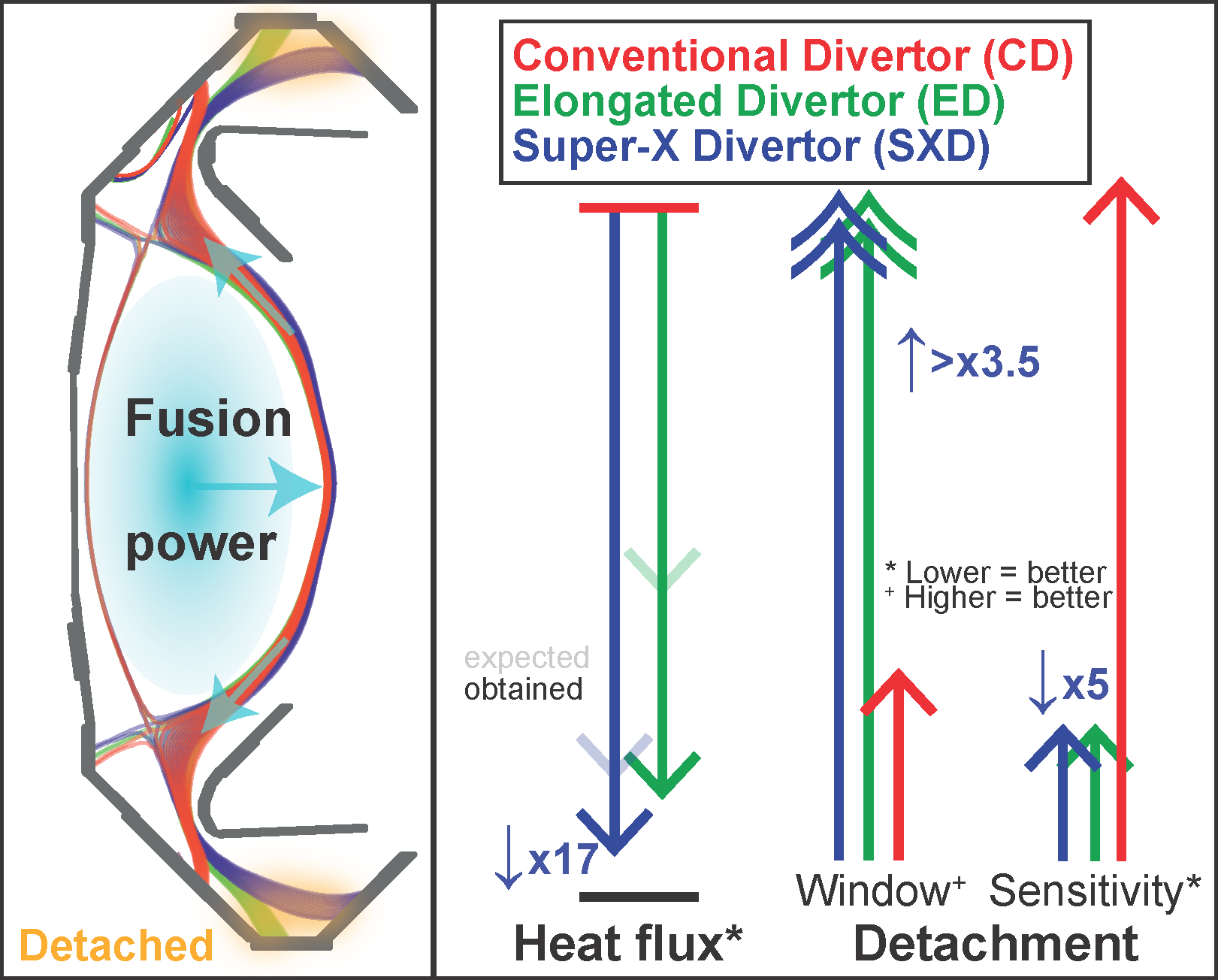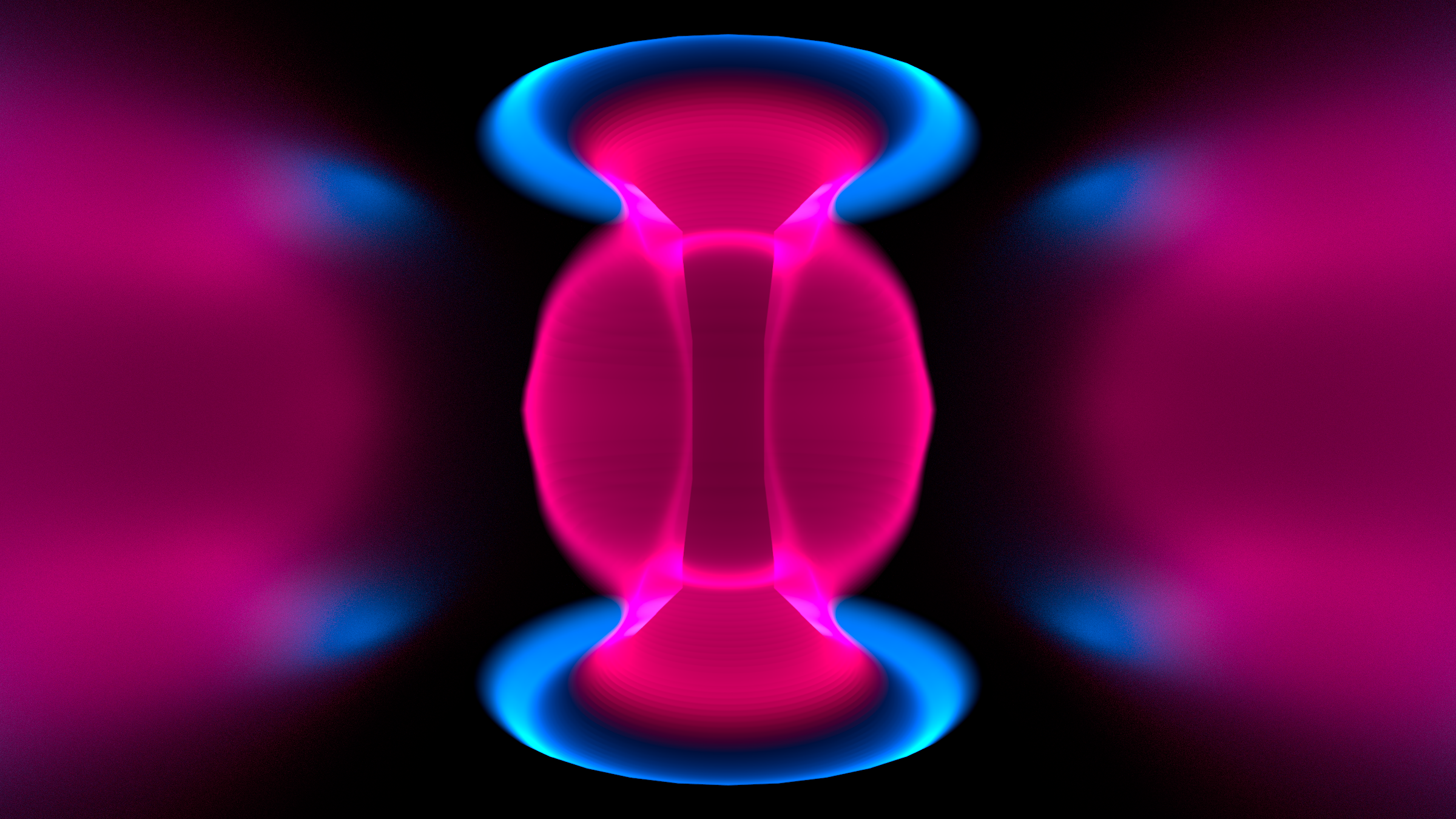Shaping the magnetic cage of a fusion reactor to solve its biggest challenge: power exhaust
Published in Physics and Mechanical Engineering

The power exhaust challenge in fusion reactors
Fusion energy is edging toward commercial reality. Large public projects such as DEMO and nimbler, privately backed concepts such as the UK’s STEP and MIT–CFS’s ARC all confront the same obstacle: removing the enormous heat that the plasma carries to the walls. Along a magnetic field line inside a power‑plant‑scale tokamak the parallel heat flux can exceed 1 GW m⁻²—roughly two orders of magnitude above the ∼5–10 MW m⁻² surface‑normal loads that even the toughest materials can survive. If nothing is done, a conventional divertor would fail in seconds.
Novel exhaust solutions are therefore not mere upgrades but enablers: they reduce risk for DEMO‑class machines and are indispensable for compact reactors, where tighter geometry drives still larger fluxes.
The UK’s flagship fusion experiment, MAST Upgrade operated by UKAEA, entered operation in 2021 with one clear mission: test advanced power‑exhaust concepts. Its signature feature is the Super‑X divertor (SXD), which lengthens the power exhaust system and introduces a gradient in the magnetic field along it. First results already hinted at >10‑fold heat‑flux reduction [1, 2]. Our latest results, obtained by a collaboration between the UK and European (EUROfusion) research communities, now provide the clearest evidence yet that tailoring the divertor topology can meet the exhaust challenge without compromising core performance.
Key results
By systematically altering the magnetic divertor topology, we uncovered a continuum of benefits that appear even with moderate shaping.
1) Heat flux mitigation up to x20. This exceeds expectations based on geometry alone by x3 from the additional volume in the longer power exhaust channel lengths.
2) Wider operational regime (> x3.5) Improved access to developing a "buffer" of neutral particles that shields the target by "detaching" the hot, ionising, plasma from the plasma-facing components. Obtaining this "detachment" is crucial in a reactor. Divertor optimisation can thus enlarge the viable operating regime of a reactor.
3) Reduced detachment sensitivity (x5). Small changes in the core quickly lead a loss of (control of) this "detachment" in conventional divertors - catastrophic for a reactor. We show that lengthening the power exhaust channel and employing a magnetic field gradient along it reduces the detachment sensitivity.
4) Improved core performance during detachment. Crucially, core performance remained indistinguishable for the different divertor geometries - even when the improved divertor designs were detached.

Our results, using new diagnostic techniques inspired by the low plasma-temperature community [4], explain the physics behind these benefits. Analysis shows that different elements of divertor shaping act synergistically, consistent with analytic reduced models [5] as well as full-fledged computational models. Plasma-neutral interactions play important roles in these benefits, requiring improvements in the treatment of these interactions to increase agreement with experiments.
Implications for reactor design
Power exhaust is one of fusion's biggest challenges and a potential show-stopper for compact fusion designs. Current reactor strategies rely on seeding high‑Z impurities to radiate away up to half of the fusion power inside the fusion core [6] - energetically expensive, potentially insufficient for DEMO and certainly insufficient for ARC or STEP. Our results show a complementary path: shape the divertor so the plasma cools itself, requiring fewer impurities. Because gains appear already after moderate changes - engineers can trade complexity against performance instead of making a binary "extremely shaped or conventional divertor" choice. Since divertor shaping comes at an increased engineering complexity and cost/size [7], this continuum viewpoint offers welcome flexiblity for next-generation fusion reactors.
Real-time power exhaust control is a tremendous challenge as reactor gas actuation respond slowly (~ seconds) to divertor changes. The reduced detachment sensitivity effectively slows the dynamics. Complementary MAST-U experiments demonstrate that closed-loop control of the detached neutral buffer succeeds in the optimised divertor shapes, but fails in the (MAST-U) conventional one [8]—evidence that divertor design and control synergies improve power exhaust control.
Next steps
-
Higher power and stronger pumping. Upcoming campaigns will raise neutral‑beam heating to 4 MW (and, in 2026, ≥ 10 MW) while utilising reactor-relevant cryopumping, approaching larger power/density ratios.
-
Finer geometry scans to inform integrated design studies. Incremental changes to the divertor shape will locate the sweet‑spot between engineering cost and physics gain. This will further validate simulations and reduced models to inform integrated reactor design studies to fully exploit the flexibilty divertor design offers in the full reactor design.
Behind the paper
These results were obtained through EUROfusion "Physics Understanding for Alternative Divertor Configurations (ADC) as risk mitigation for DEMO" team, driving collaborative, multi-device, research on ADCs in Europe. The parameter space that can be studied with ADCs is far beyond what can be investigated in "conventional" divertors. This makes ADC studies vital for validation study of both modelling and real-time control techniques for ITER. While UKAEA supplied the novel MAST-U facility, partners across Europe, the UK and the US provided diagnostics, analysis codes and fresh perspectives. That EUROfusion collaboration has already demonstrated real‑time detachment control on MAST‑U [8] and, more recently, the benefits of the extreme X‑point‑target configuration on the Swiss TCV tokamak [9]. These EUROfusion research achievements advance the technological readiness level of ADCs, advancing this enabling technology to provide key innovation in next-gen reactor design [11].
MAST Upgrade's Super-X divertor can almost be too effective: during the highest-power experiments (~4 MW) the Super-X stayed detached no matter how hard we tried to re-attach it. Early spectroscopic analysis [4] showed the divertor was too cold for standard fusion data tables. Presenting those first measurements and analysis in a "low-temperature plasma" session at the EPS Plasma Physics conference felt ironic - and satisfying.
Ultimately, there is no single silver bullet for power exhaust, but shaping the magnetic topology gives designers a powerful new dial. It adds complexity up front, yet promises longer component lifetimes, higher fusion gain and more compact, economical plants down the road.

[1] C. Theiler, B. Lipschultz et al. Nucl. Fusion (2017)
[2] J. R. Harrison et al. Nucl. Fusion (2024)
[3] K. Verhaegh, B. Lipschultz et al. Nucl. Fusion (2022)
[4] D. Moulton, J. R. Harrison et al. Nucl. Fusion (2024)
[5] B. Lipschultz, F. I. Parra, I. H. Hutchinson et al. Nucl. Fusion (2016)
[6] L. Xiang, F. Militello et al. Nucl. Fusion (2021)
[7] R. Kembleton, M. Siccinio et al. Fusion Eng. Des. (2022)
[8] B. Kool, K. Verhaegh et al., arXiv:2407.07784 (2024)
[9] K. Lee, C. Theiler et al. Phys. Rev. Lett. (2025)
[10] M. Wigram, B. LaBombard et al. Nucl. Fusion (2019)
[11] EUROfusion "How to meet the power exhaust challenge with alternative divertor configurations" (2025)
Follow the Topic
-
Communications Physics

An open access journal from Nature Portfolio publishing high-quality research, reviews and commentary in all areas of the physical sciences.
Related Collections
With Collections, you can get published faster and increase your visibility.
Higher-order interaction networks 2024
Publishing Model: Open Access
Deadline: Feb 28, 2026
Non-Markovian quantum dynamics in physical systems: description and control
Publishing Model: Open Access
Deadline: Dec 31, 2025





Please sign in or register for FREE
If you are a registered user on Research Communities by Springer Nature, please sign in
Please read this article and give your opinion. If you disagree with anything, please state the place and reason where you disagree.
https://docs.google.com/document/d/12584o9sol-RpSsbLonLkIewdVtiwvqX7gHy_k8CHTg8/edit?usp=sharing
Electrodynamics - Maxwell's equations in particular - already provide a unified picture of light, magnetism and electricity. Electromagnetic forces and energy are governed by photons (i.e., light), which are effectively an information carrier between charged particles. Introduction to Electrodynamics by D. Griffiths is an excellent book on electrodynamics. Studying electrodynamics would enable you to build your ideas on top of that - after all, science progresses by standing on the shoulders of giants.
If I ask you to tell me if you know of any flaws, you're just making me and Maxwell's clash. Maybe if Maxwell's had watched it, they would have praised me.
There is no Contradiction between Maxwell and me.